Rear View Mirror
Volume 8, No.3
Author
- Don Capps
Date
- October 4, 2010
Download
- RVM Vol 8, No 3 (PDF format, 811kb)
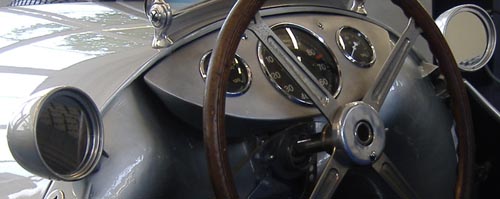
“Pity the poor Historian!” – Denis Jenkinson | Research is endlessly seductive, writing is hard work. – Barbara Tuchman
A Requiem on Serial Reflections
Or, Goodbye to All That and Other Sighs of the Apocalypse
I am certainly not one to waste much time with getting all misty-eyed over nostalgia or the sort to be of blubbering on and on about a past that never was quite as golden as fading and selective memory tend to make it these many days later,1 but I do get this urge to merely sit and sigh whenever I begin to rummage through my serials while looking for something. Yes, I persist in calling magazines serials since, well, that is what they are, aren’t they? While it might be seen as merely an affection of the life scholastic – with some justification, I might add – it is actually an indication as to how one actually thinks about them. Ponder that concept for a moment.
While my collection of serials is not quite what it once was, and while it is certainly overmatched by many others, it is a never-ending source of both assistance and amusement to me. Although I have little problem with digitized serials – an approach strongly endorsed by wives everywhere I understand, mine being among the leaders of the movement – and found them an incredibly useful asset while cooling my heels in the Middle East for the better part of three and a half years, there is nothing quite like the tactile presence of a real, words and pictures on paper, serial resting in your hands.
Of course, my enthusiasm for tactile serials loses much of its edge whenever I cast a eye on the latest edition of Road & Track or just about any other serial you might wish to name. Indeed, my recent visits to bookstores and a perusal of their magazine – yes, in that context they revert to being mere magazines once more – racks is little reason to cause the heart to get all aflutter with the choices. Of course, this is long been the case, being as true decades and decades ago as it is today. Hard to imagine that once upon a time that Car and Driver and Road & Track once were wonderful sources for information about motor racing, both race reports and all the other odd bits and pieces that went with it.
For reasons owing more to continuing to prove that Tuchman’s Law continues to be valid than anything else, I recently found myself beginning to read and re-read many of the serials with the realization that just perhaps – perhaps, mind you – the golden age of words and literacy could be in the past after all. Either that or I am the victim of my preferences an inclinations. To read an issue of On Track in its heyday or spend time with an issue of Sports Car Graphic or Motor Sport were moments well-spent. That each had its own distinct voice was merely accepted as a matter of course. However, by the latter part of the Eighties it was evident that television was, let us be honest, “dumbing down” the serials. As more and more racing appeared on television, there was a corresponding decline of the serial, only a few newcomers bucking the trend, and few of them lasting very long.
I always thought it a bit frightening, if not downright unhealthy, that one should be able to simply glance at the cover of a serial and know – and I mean know – its contents.
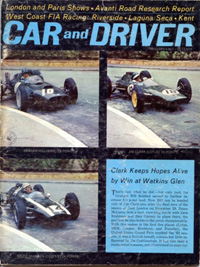
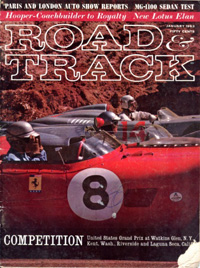
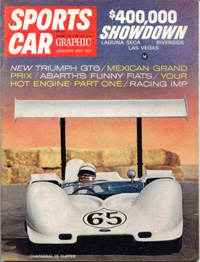
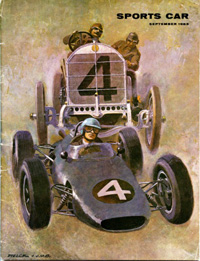

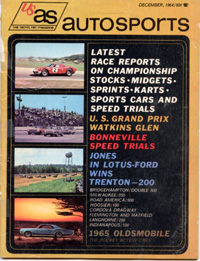
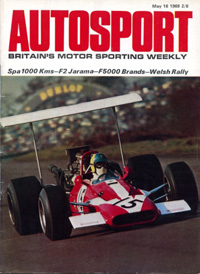

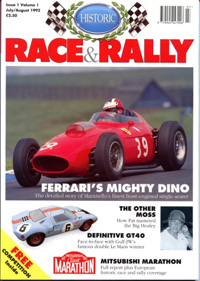
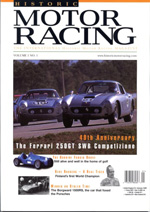
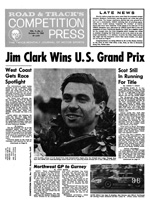
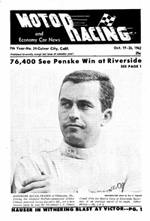
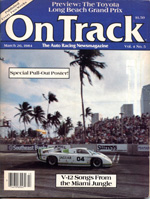
Although any or all of these serials could be as insipid and mindless as anything published in a magazine today, what continues to create a sense of amazement is the sheer number of words that often appear in these serials. At any rate, I could not help myself and decided to toss in a bit of “eye candy” for those who may cast their eyes upon these pages.
Car and Driver began life as Sports Cars Illustrated in the Summer of 1955. I bought my first copy of SCI somewhere along about this time, certainly not any later than early 1956. Under editor Karl Ludvigsen, SCI became Car and Driver beginning with the April 1961 issue. Until some point in late 1963 or early 1964, C/D included a fair amount of information on motor racing, but during this period it transitioned into what I always considered an automotive version of The New Yorker, only focused on car people. By the latter part of the Sixties, I had pretty much abandoned any real interest in Car and Driver, its lack of motor racing and editorial smugness being the primary reasons, but I continued to subscribe until some point in the early or mid-Seventies, finally giving it up as a lost cause.
The first issue of Road and Track appeared during the Summer of 1947, a product of the East Coast, New York City. After several issues on the East Coast, it followed one of its originators to the West Coast – he was an aeronautical engineer – and after a cycle of ups and downs, success and disaster, the magazine finally began to find its niche once John R. and Elaine Bond took control. In early 1954, it became Road & Track, the “and” being dropped and the ampersand taking its place. It was about this time that I first encountered R&T, a relationship that would last until 2000, well over four decades, before the subscription finally – and mercifully – lapsed at long last. By then, I had stopped reading the magazine, perhaps scanning the contents page for what was featured in the salon section, rarely spending more than a quarter to half an hour an issue before relegating it to the stacks, unlikely to ever be read again, unlike its earlier companions from decades earlier.
I have long found this sundered relationship with Road & Track unfortunate. As it became a commodity and the editorial focus and the publisher changed – I remember CBS buying it at one part as part of its magazine publishing effort, an inevitability given the highly volatile state of the periodical business, of course, R&T seemed to be traveling down one path while I was ambling down another. It was a out of a sense of loyalty – however misplaced that may have been – and cheap subscriptions that kept R&T arriving each month, long after it ceased to be anything but just another piece of mail.
In its day, roughly from 1950 or 1951 through about the early to mid-Eighties – about 1984 or 1985, Road & Track was always interesting to read, even if one may not necessarily agree with its ideas and opinions about things. Road & Track, in my view at least, went out of its way to make itself something of a voice for The Establishment when it came to sports cars and road racing and such. Today I can very easily visualize the slightly curled lip, the faint sneer, the condescending manner with which R&T tended to treat anything not sufficiently European or in keeping with how “sports car people” should act. At the time, this sort of thing provided both guidelines as to how to think, if you will, and reasons for puzzlement. Having dealt with the British firsthand and having lived for many years in Europe, but by the early Sixties I was not as enthralled as those at R&T were with those things European.
However, the main reason I bought and then subscribed to Road & Track for so many years had less to do with Bond’s Miscellaneous Ramblings or the often ridiculous cars that were the staple for its road tests: it was the race sports and the other items related to automobile racing. For years and years, the racing coverage simply got better and better and better. The introduction of first Bernard Cahier, then Henry N. Manny III, and finally (for me) as their Continental Correspondent or Grand Prix reporter meant that R&T became a staple item on my reading list each month. I had met Henry Manney while in Europe and found his writing quite a bit more entertaining than HNM in person at times. However, his writings are easily the best produced in the arena of motor sports journalism. I hope that is not damning with faint praise given my views of what “motor sports journalism” can be compared to, but my feelings about Manney’s writing is genuine, it was good then and it is still a pleasure to read his race reports and other articles that graced the pages of R&T. Of course, I plead guilty to thinking, Heavens! If he can get away with doing that, maybe I should try it as well...
Then there was Sports Car Graphic, a product of the ever prolific Robert E. Petersen Publishing Company. It was fascinating to find out that Petersen got his start as a magazine editor and publisher at the ripe old age of 16, putting together and selling to the local hot rod crowd in Southern California what would become Hot Rod Magazine, the magazine that every true-blue, red-blooded American teenager and youth read when I was growing up. It was full of a never-ending string of things mechanical and automotive that fed our hunger for such information. While never much of a hot-rodder, I was smart enough to recognize genius and craftsmanship when I saw it.
During the Fifties, Petersen developed a strategy that would create a specialty magazine whenever such a group could be identified as a market. In this way, Hot Rod Magazine led to, for example, Rod & Custom and Car Craft magazines, among others that would come and go over the years. Soon after starting Hot Rod Magazine, Petersen created another of the cornerstones of the American automotive magazine world: Motor Trend. Among the various efforts of the Motor Trend enterprise was the creation of Motor Trend’s Sportscar Quarterly in 1958, which morphed then into Motor Trend’s Sportscar Graphic, before finally becoming Sports Car Graphic with the May 1961 issue.
For reasons not always easy to explain – or understand for that matter, I always liked SCG. Where Road & Track could be pretentious and Car and Driver perhaps a bit too East Coast Cool and Hip, Sports Car Graphic was clearly more the scion of Hot Rod Magazine, perhaps a bit more so than its actual parent, Motor Trend, in my opinion. It was clear that SCG moved to another rhythm than its competitors. If there was anything that demonstrated this difference it was that at SCG the inmates often seemed to run the asylum. Although not anywhere as much of a techno-freak – pseudo-Sixties language – as many others, even I was interested (and often fascinated) by the various SCG project cars and their endless tinkering with cars.
An interesting policy that SCG had during it early years was that it did not provide race results in tabular form or as a separate part of the race report. If you wanted to know the results, read the report, was their philosophy. One of the reasons that SCG was liked, in my thinking, was that it was about the only monthly that covered most of the important national-level racing events, something that R&T once did, but dropped by the time that SCG appeared. More on that later.
At any rate, Sports Car Graphic seemed to hit a few rough patches by the end of the Sixties, by 1970 it was not quite what it had once been, which was a surprise in some ways and should not have been in others, in retrospect. It seemed to lose its way, apparently not sure of either its audience or its focus or direction. In the Summer of 1971, it went full circle and was incorporated into Motor Trend. There were later attempts by Petersen to float SCG in various forms, but it never caught on, nor were the issues I saw all that great for the most part.
Sports Car was the official publication of the Sports Car Club of America, the publication starting off being entitled as Sportswagen, not the greatest name for a publication in the 1944-1945 period. Beginning as a mimeographed newsletter – often with photographs that went with an article taped next to it – and then becoming a slick magazine by the early Fifties, it was one of those magazines that I later envied those with the early issues since that seemed to be the only place that you could find results in any depth for many of the early SCCA National events. At some point in the Seventies it changed format and did so again later and then once more and so forth and so on. Sports Car was never part of my routine reading matter, primarily due to I was not an SCCA member, but I did have access due to friends who had copies.
I first encountered Motor Sport around the end of 1953 or early 1954. It was sold at the Stars & Stripes newsstand that sat next to the entrance to the American Express bank at where Dad was stationed at the time. In addition to the usual selection of American periodicals, the newsstand carried a good selection of British periodicals, including both automotive and aviation magazines, the ones that interested me the most. I am not sure if it was love at first sight, but it was close, I suppose. That I would later encounter the person behind those initials – D.S.J. – that were at the end of most of the race reports was quite a thrill.
The problem with Motor Sport was leaving Europe meant real headaches trying obtain copies back in the States. Fortunately, we quickly returned to Europe and that problem was solved, at least for several years. However, when Dad decided to retire and return to the States, I faced that problem once more. The subscription service left much to be desired in those days. I speak from experience. However, where there is a will, there is usually a way. It took a bit, but I finally worked out a deal that provided me with Motor Sport on a somewhat routine, recurring basis for a number of years.
I ended up with few of my early issues of not only Motor Sport, but many other serials as well, when the place my books and serials were being stored had a water leak, one that went undetected for a fairly long time. By the time that the leak was discovered, a massive clump of pulp was about all that was left of many of my serials and quite a few books as well. I will attempt not to break down and sob uncontrollably at this point, but that was pretty much my reaction at the time. I had dragged most of these serials and books around for years upon years, fought many a battle with my parents over them, and spent pretty much every spare penny on them. It was a real blow. Although I managed to replace some of them over the years, for many this is simply difficult to impossible due to either the costs involved or that they are simply not to be found.
Thanks to the magic of digitization, however, I now not only have replaced those lost and filled in the gaps, but can include issues that I had never read before. Perhaps it just me, but as much as I much prefer the tactile sensation that comes only from handling – almost fondling at time – a real book or serial, I can deal with the digital issues quite readily. Part of this is due to the notion of better something in electrons than nothing, as well as the idea that I can always print it off. This is perhaps not the same, but close enough when your need is for research and not trying to be a member in good standing in the Gordon Gekko Book Club.
About fifteen or even twenty years ago, Motor Sport began to struggle. It simply got worse and worse and worse, just completely adrift. Since then, it had been sold, tried to re-invent itself, been sold or something, and once again re-inventing itself. I continue to subscribe to it, but I often just wonder why, other than it just being habit and the hope that it might actually find its niche, of course. The current version of Motor Sport is certainly better than it was decade ago when they ran that horrid and utterly hopeless article by Mark Hughes on the 1933 Gran Premio di Tripoli that appeared in the February 2000 issue (that that I would mention that, of course), simply parroting what Neubauer wrote. Yes, I was asked to participate in one or two of their “top one hundred” whatever lists, for which I will burn in hell, I imagine.
One day US Autosports was there – it arrived as Auto Sports in 1962 and then renamed itself in early 1964, and then a few days later it wasn’t. It just was one of a number of similar magazines that arrived and departed on a regular basis at the newsstands, but it was interesting to me since it had such an eclectic coverage of events, something for which I am very grateful all these years later. It could be a bit bewildering and even downright strange in what it chose to appear between the covers, but that was a major part of its appeal to me. It should be noted that its coverage was focused largely on the Midwest, not surprising given that it was published in Gary, Indiana.
I am not certain that US Autosports survived into 1965, but its coverage of 1964 was quite good, covering a wide range of events and often doing a very good job of it. The issue shown, for instance, was the December 1964 issue and it contained reports – or at least a short article – on Foyt winning DuQuoin and several other USAC Championship Trail events, the Bonneville speedweeks, Parnelli Jones winning at Trenton in a Lotus, USAC and NASCAR stock car racing events, the Road America 500, and the United States Grand Prix, plus various other odds and ends. In earlier issues covering the 1964 season, it provided some of the best coverage of the SCCA US Road Racing Championship events, as well the Daytona 500, the USAC Championship Trail, stock car racing whether it was NASCAR, USAC or ARCA, plus it even gave coverage to Sprint Car racing.
Ah, Autosport, which shares the same fate as Road & Track and Motor Sport as being once loved, but now scorned. Along with Motor Sport, one of the British magazines carried by the Stars & Stripes newsstand was Autosport. As with Motor Sport, love and affection at first sight, an affair that lasted from about 1954 until 1998 when I cast it out into the darkness, vowing that I would never, ever subscribe to it again. Since then, I have actually purchased a few copies, but very few. Nothing has changed my low opinion of the magazine, alas, which is really very sad.
In retrospect, many of the earlier issues of Autosport were not all that wonderful, but Gregor Grant had the good sense to find things to keep people buying each issue, the “Case History” articles by Norman Smith being just one of the things that he did. By the latter Fifties and early Sixties, Autosport had really hit its stride as something other than just an automotive magazine for domestic consumption. Along with Motor Sport, it was THE magazine for the American purist to have in his possession. The race reports and the racing related columns and articles were simply top notch. To pick up an issue produced by Simon Taylor today is to discover why anoraks became anoraks.
So, where did it go wrong? It was probably in the latter part of the Eighties, I would suggest, certainly by the early Nineties. I believe it was poisoned by formula one. It seemed to lose its perspective on things, the coverage it provided on the FIASCO War was absolutely top notch, which, sadly, was unmatched at the time and certainly not since then. By 1998, for me at least, any magic was long gone with the spiraling subscription costs and the lack of any motivation to read each issue simply making it a no-brainer to halt the madness of spending a fortune for a magazine I no longer cared for.
It has managed to get worse in recent years, which I never assumed to be possible, in large part due to garish, unreadable layouts, primary school writing, and what can only be described as pandering to the wretched “fanboyz” phenomenon. Of course, there could just be a huge generation gap at work here as well. Of course, given the overall deterioration of the automotive press in recent years, that might not be entirely the case. There is also the television factor, which leads to a shorthand in the coverage of events and which would make the presence of someone like Pete Lyons gracing its pages difficult to impossible to imagine today. I must admit that I have probably never been that much of a Nigel Roebuck “fan,” heresy of the first order to some I realize, but a lot of Roebuck goes much further than one can imagine.
I think that I saw an advertisement for Formula somewhere and, sight unseen, subscribed. The first issue I received was the March 1975 issue, which was Volume 2 Number 2, so it had been for awhile before I somehow latched on it. In a very short time, Formula became an excellent magazine, one of those who presence in the mailbox was a cause for celebration. It evolved from coverage of only those things dealing with the usual “formula” matters – formula one, Super Vee, FF, 5000, USAC, and so on and so forth – to include the IMSA Camel GT series. Along the way Paul Oxman bought the magazine and it gave us both good writing and more often than can be imagined today, superb graphics.
At about the end of the Seventies, Formula became Racecar, hitting some rocky shoals, floundering a bit, not unlike a number of other magazines at this time. The issues of Formula and Racecar provide one of the best time machines for examining that era, especially the US scene, which often gets short shrift it seems by the purists and enthusiasts it would seem.
I am not sure how I managed to stumble upon Historic Race & Rally, but I do remember thinking that it was doomed from the outset. It was simply too good to be true and that later proved to be the case. The first issue carries the date July/August 1992, with the sixth – and last it seems – issue being dated October/November 1993. With the contents often being something of a hodgepodge – a nice hodgepodge it must be said, the forever shining star of Historic Race & Rally were the Doug Nye contributions to each issue.
From a detailed look at the front-engined Ferrari Dino cars in the first issue to an in-depth look at the Vanwall in the last issue, along with his “Inside Track” column that appeared in each issue, Doug provided manna to those starved for articles that were written by someone who knew what he was he talking and who could actually string literate, coherent sentences together to make paragraphs that simply did not exist elsewhere. The coverage of the Mercedes W154 series in two of the issues, three and four, by Doug Nye, was extraordinary by any measure. That it was shared and Doug took the trouble to painstakingly correct what he had written in issue three with detailed notes in issue four was the sort of stuff that was rare then, and nearly extinct now.
The loss of Historic Race & Rally was followed some years later another with the rise and fall of Historic Motor Racing. Edited by Graham Gauld, it was just really beginning to establish itself when the plug got pulled, leaving another vacuum, another empty space on the shelf. Although I am not able to generate as much enthusiasm for vintage racing and so forth as others, what the magazine was providing was an outlet for the sorts of articles that just would never get much of a chance elsewhere. As someone who had – as well as continue to have – nothing but the highest regard for Graham prior to the appearance of Historic Motor Racing, I was very saddened to see it go under. Of course, that I probably had an article or two in the pipeline also contributed to that sense of loss.
An unfortunate problem with serials printed in tabloid form is that their longevity is often more problematical than the usual sorts of periodicals, a problem not helped by the regrettable tendency of the tabloids to absorb moisture. I did not read a copy of Competition Press until sometime in 1961, although I was aware of its presence long before that. It was originally an attempt by Road & Track to provide a bi-weekly tabloid that focused primarily on the “track” aspect of Road & Track. If you look carefully, you can clearly see that the title of the issue displayed clearly states that this is Road & Track’s Competition Press, not merely Competition Press. I did finally manage to become a regular reader, but not long after that, in April 1964, it was now Competition Press and Autoweek. Then, in 1965, it became Competition Press & Autoweek, with the “Autoweek” being in larger letters rather “Competition Press” as had been the case prior to that.
At some point, the “Competition Press” part was completely dropped and it became simply Autoweek. In the early Eighties, Autoweek finally abandoned the tabloid format for the usual magazine format. By then, there was much, much more coverage on the automotive scene than that of the motor racing scene. At about this point I dropped any real interest in Autoweek, although I did subscribe a few times over the years, but it finally, even at a minimal cost, simply not worth it.
Perhaps, having enjoyed CP during its halcyon days, I expected too much. That or it simply was not worth the trouble since other serials I was reading completely and utterly trounced it when it came whatever racing coverage that was in an issue of Autoweek. When my library was in storage and the long undetected water leak attacked it, the tabloids were among the major casualties, my collection of Competition Press being utterly devastated, none of those in storage surviving. Nor did my issues of Southern Motorsports Journal or Southern MotoRacing, nor did those issues of National Speed Sport News or Illustrated Speedway News, among the others in this format. The loss of the first two was truly devastating, since their coverage of Southern automobile racing was about all there was to be had at the time. It is still difficult not to shed a few tears when I contemplate their loss. It was not a complete collection of either, but pretty close.
Not until I got the entire run in digital form from the late Bob Norton, I had only a few copies of MotoRacing, a West Coast magazine. I had only seen a handful of the magazines to begin with, all of them in the possession of a friend whose parents seemed to subscribe to every automotive magazine known to mankind that dealt with sports cars or motor racing. At a secondhand book store in the early Seventies, I stumbled across a few copies of MotoRacing while looking for something else, of course. All dozen or so issues were from 1961 and all died in the water leak. I have come to appreciate the value of this serial in my research, it often being used to provide information that simply is difficult elsewhere. From its beginning in 1955 until it changed from the tabloid format in early 1964, it is one of the first places I look for help if the topic is road racing during that time span.
Then there is On Track, which was the continuation, of sorts of the Formula or Racecar way of doing things. It appeared early 1981 and after the usual changing of publishers, from Paul Oxman to Griggs in the Nineties, slipped into magazine heaven at the end of 2000. In my opinion, even when its focus had become a bit muddled towards the end, it was the best of the American automotive magazines in the latter part of the Twentieth Century. It appeared in tabloid form for the first two years before switching to a magazine format, a move which often seems to be the kiss of death. In this case, however, On Track scarcely missed a beat and simply went from strength to strength.
If the British domination of English language periodicals devoted to motor racing ever had a worthy competitor, it was On Track. The coverage of IMSA and CART and the NASCAR Winston Cup Series in On Track was simply unmatched, as well as it coverage of the SCCA professional events and the international scene, formula one – of course – and whatever else the FIA had going on at that moment. Its demise was a dark day for me and, I assume, many others. Nothing has come along that even comes close in recent years. Although I subscribed to Racer for a number of years, Racer never held a candle to On Track. Period.
There are, of course, a number of other serials that I have not discussed. I was never that big a fan of National Speed Sport News, for reasons that I really don’t fathom, other than it just never quite struck the right tone with me. I think it was more me than Chris Economaki and the others at NSSN. Taking a look at many of the older issues, I still have that same sense of, well, there is something still missing.
Once upon a time, I thought that IndyCar Racing would become a really good magazine, getting off to a very strong start in the first year or so. However, as in the case of many other magazines, it got lost as it moved forward in years, going to a tabloid format that simply missed the boat, before reverting to a magazine format that generally left much to be desired, far too many of the articles being “puff and fluff” pieces. Far too many magazines in recent decades seem to think that “puff and fluff” is the way to go, F1 Racing and any number of NASCAR and other series-specific periodicals sinking to that level.
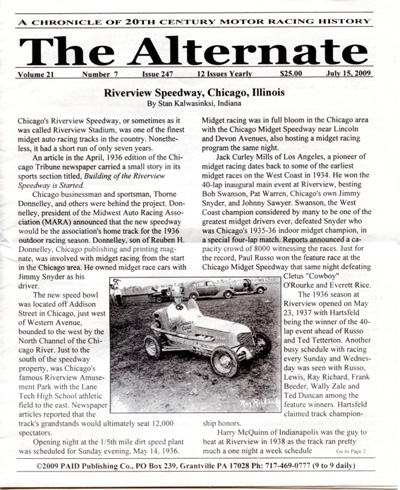
Then, there was The Alternate. The product of a single-minded and determined lady from outside Harrisburg, Pennsylvania, Phyllis Devine, The Alternate was the sort of publication that only love and devotion to a topic could have produced. It was a delightful mishmash of articles – of which there was always one being presented in serial form it seemed, observations, book reviews, and whatever else Phyllis Devine wanted to place in sixteen crammed pages, which included one for the address information.
Although I came somewhat late to The Alternate, it was one of those little jewels I looked forward to reading when it arrived. While some might look upon me with some askance and question my thoughts on this little monthly, they are missing the point: this was the sort of thing that only the brave few dare to attempt and even fewer keep going for year after year, nugget after nugget being harvested. When Phyllis Devine died, The Alternate, of course, died with her. It was a very sad day for automobile racing historians when this happened. We are so much the better for having had Phyllis in our midst.
Indianapolis Motor Speedway: 1909
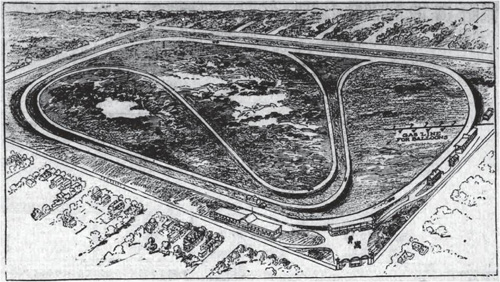
Here is a view of the proposed layout for the Indianapolis Motor Speedway from early 1909 which shows the original road course configuration from an angle that is not often shown.2 I found this while looking for something else, of course, but it is always a good starting point for a “what-if” drill to imagine what may have come about should the road course been built as shown and the Vanderbilt and Grand Prize events used the venue.
Notes
- One of the great values of a graduate education is that it introduces you to books that might not otherwise cross your path or catch your interest. One of the great finds of my seemingly endless hours toiling in the library stacks and sitting in my carrel for hours upon hours reading and writing was to come across a wonderful book by Otto L. Bettmann, The Good Old Days – They Were Terrible!, New York: Random House, 1974. It played a significant role in my changing my ideas about nostalgia and the longing for the past that seems to pervade the thinking – and certainly the writing – of many amateur historians. It was also a reminder that history is written in the present about things often long past, but that should be wary of not just anachronistic thinking, but forgetting to consider the past on its own terms.
- The Bisbee Daily Review, 2 May 1909, p. 10.
